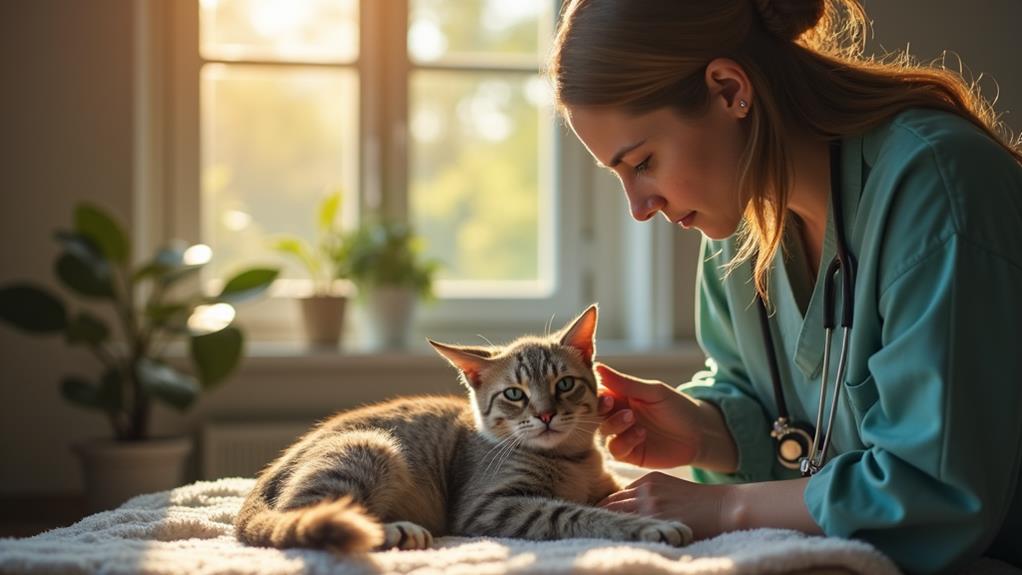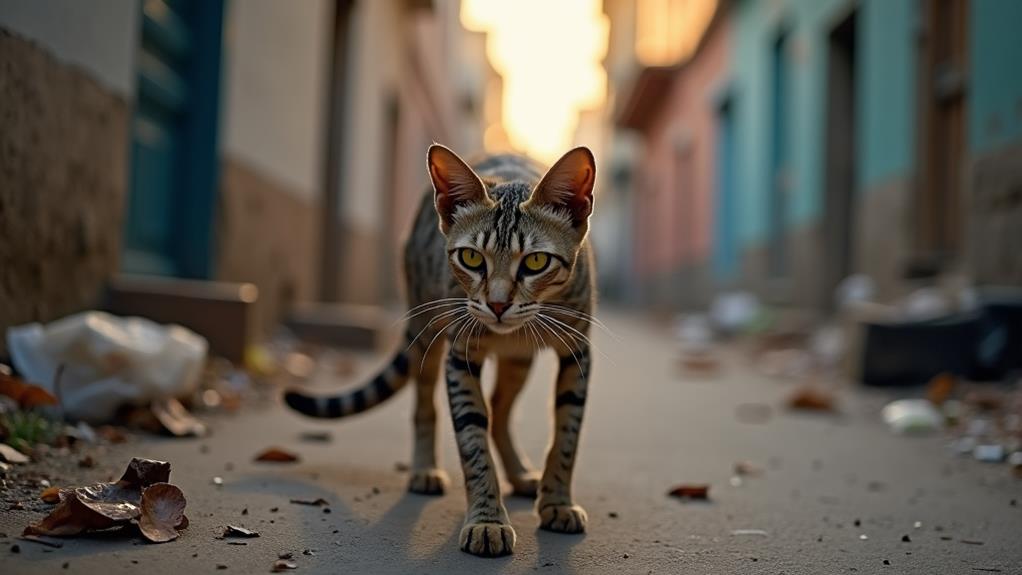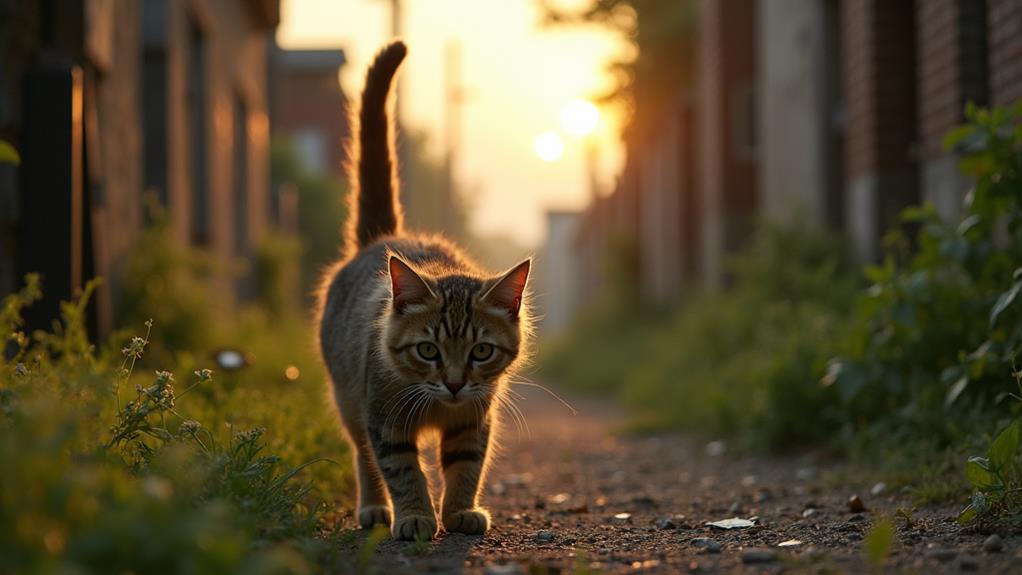What to Do If a Feral Cat Is Dying: Compassionate Care and Euthanasia

If you find a dying feral cat, focus on compassionate care by creating a warm, quiet space. Gently observe for signs like panting, hiding, or not eating. Get advice from a community cat-friendly vet on pain management and hospice care. Avoid trapping unless necessary to prevent stress. If the cat shows severe distress, urgent veterinary attention and discussion about euthanasia options might be needed. Making informed, compassionate choices will help the cat and bring you peace. Seek emotional support from fellow caretakers as you navigate this tough situation. There's so much more to reflect on about this delicate process.
Understanding Feral Cat Behavior
Understanding feral cat behavior is vital for anyone involved in their care. Feral cats, unlike their stray counterparts, have adapted to living outdoors without regular human interaction. They're typically unsocialized and exhibit behaviors such as wariness or aggression when approached. This instinctual avoidance can make managing their care quite challenging. However, by understanding these behaviors, you can better guarantee their well-being and support their shift to healthy cats.
Feral cats communicate using vocalizations, body language, and scent marking. They may display signs of stress or discomfort through actions like hiding, excessive grooming, or aggressive posturing. Recognizing these behaviors is key to evaluating their health and confirming they're healthy cats. For instance, if a feral cat becomes more withdrawn or avoids usual activities, it might indicate underlying health issues.
Observing these subtle changes can guide you in providing appropriate care. It's important to approach them with patience and respect, considering their natural instincts and boundaries. By understanding their behavior, you'll be better equipped to provide compassionate care, guaranteeing they remain as healthy as possible in their unique environment.
Identifying Signs of Suffering
Noticing the subtle signs of suffering in feral cats can be a challenge, but it's vital for ensuring their well-being. Feral cats often hide their pain, making it difficult to know when they need help. However, there are tell-tale signs that you can watch out for to determine if a feral cat is suffering and might require immediate veterinary attention.
- Breathing Issues: If you notice a cat excessively panting or gasping, it could be experiencing distress or pain.
- Behavioral Changes: Increased shyness, excessive hiding, or becoming unusually still can be indications that something is wrong.
- Appetite Decline: Pay attention to changes in eating habits. A sudden food pickiness or complete loss of appetite may signal a serious health issue.
- Avoidance of Human Contact: While feral cats naturally avoid humans, an increase in this behavior might suggest they're in discomfort.
It's significant to monitor these signs closely, as they can help you determine when a feral cat may need immediate veterinary attention. Regular vet check-ups are also vital, as they can identify underlying health problems that might cause suffering. By staying observant, you'll be better equipped to provide compassionate care.
Assessing the Situation

After identifying signs of suffering in feral cats, evaluating the situation becomes the next step in providing compassionate care. Start by observing the cat for subtle signs such as excessive panting, hiding, or changes in eating habits. These behaviors can indicate distress or pain, essential indicators when examining a dying feral cat. Approach the cat gently, as feral cats are often wary of human contact, and sudden movements can cause further stress.
Consulting a community cat-friendly veterinarian is important. This professional can evaluate the severity of the cat's condition and suggest appropriate care options. They understand the unique challenges of working with feral cats and can offer advice on the best course of action. Avoid trapping the cat unless absolutely necessary, as it can increase stress and potentially worsen their condition. Instead, if the issue seems mild, consider letting the cat heal naturally in its familiar outdoor environment.
Regular vet check-ups play a key role in monitoring the health of feral cats. If you notice signs of illness or injury, seek timely medical intervention. By carefully examining the situation, you're ensuring the cat receives the most compassionate care possible.
Providing Comfort Care
Providing comfort care for a dying feral cat starts with creating a sanctuary that meets the cat's needs. A safe and quiet space free from stress and disturbances is crucial. You'll want to monitor the cat's behavior closely. Look for signs of suffering, such as excessive panting or changes in eating habits, to evaluate its comfort level. Administering pain relief and medications, as prescribed by a vet, can greatly improve the quality of life for a terminally ill feral cat.
Consider these steps to provide comfort care:
- Create a peaceful environment: Choose a warm, enclosed area that offers the cat privacy and protection from loud noises and other animals.
- Monitor for signs of distress: Keep an eye on the cat's breathing, behavior, and eating patterns to verify it remains as comfortable as possible.
- Provide nutritional support: Offer foods that the cat finds appealing to encourage eating, and make certain fresh water is always available.
- Consult a veterinarian: A vet with feral cat experience can provide guidance on pain management and other hospice care options.
When to Contact a Vet

Caring for a dying feral cat requires vigilance and compassion, and sometimes, professional intervention becomes necessary. If you notice signs of severe distress in a feral cat, such as excessive panting, hiding, or lethargy, it's essential to contact a veterinarian. These behaviors can indicate serious health issues that need immediate attention. By consulting a community cat-friendly veterinarian, you can discuss the cat's symptoms and determine if emergency medical intervention or hospice care is appropriate.
When reaching out to veterinarians and animal specialists, providing detailed observations of the cat's behavior and health changes is significant. This information helps in making accurate assessments and recommendations. Regular veterinary check-ups are also beneficial, as they help catch potential issues early, ensuring the cat receives timely care.
If the cat's suffering seems unmanageable and its quality of life is compromised, it may be time to discuss euthanasia options with the veterinarian. This conversation can guide you in making a humane decision about euthanizing cats, ensuring the cat's end-of-life experience is as compassionate as possible. Seeking professional guidance at the right time can make all the difference in providing a dignified and caring passage for a feral cat.
Making Euthanasia Decisions
Deciding on euthanasia for a feral cat is never easy and requires careful thought and sensitivity. When a cat's suffering can't be managed, it's essential to engage in open discussions with a veterinarian about the cat's condition and prognosis. Your goal should always be the welfare of cats, guaranteeing that any decision made prioritizes their well-being. Here are key considerations:
- Thorough Assessment: Confirm the cat's health is accurately assessed. Healthy cats with treatable conditions shouldn't be euthanized.
- Explore Alternatives: Consider all possible care options, such as in-home hospice care, before deciding on euthanasia as a last resort.
- Emotional Awareness: Recognize the complex emotions involved, including grief and guilt, and seek clarity through communication with professionals.
- Complex Decisions: Understand the complexity and conflicting feelings that may arise, focusing on what truly serves the cat's best interests.
Ultimately, making euthanasia decisions involves weighing the cat's quality of life against potential suffering. By considering these factors, you can make an informed choice that honors the dignity and welfare of the feral cat in your care. Remember, the decision should always reflect a compassionate approach to the cat's needs.
Emotional Support for Caretakers

Steering through the emotional challenges of caring for feral cats, especially when faced with end-of-life decisions, can be overwhelming for caretakers. You might find yourself grappling with grief, guilt, or regret, which emphasizes the need for emotional support during these difficult times. Acknowledging these feelings is essential, as it allows you to process your emotions and seek the support you need.
Engaging in open communication with veterinarians can provide valuable guidance and reassurance, helping you navigate tough choices regarding euthanasia and hospice care. They can offer insights that may ease your burden and clarify any doubts. Moreover, connecting with support groups or fellow caretakers can mitigate feelings of isolation. Sharing experiences and coping strategies in these spaces can be incredibly therapeutic and provide the camaraderie you might be missing.
Furthermore, researching available resources like hotlines or counseling services can empower you to find the emotional support necessary for making these end-of-life decisions. Remember, it's okay to seek help and lean on others during this challenging time. Your dedication to compassionate care is admirable, and finding the right support can make this experience a bit more bearable.
Finding Veterinary Services
Locating the right veterinary services for feral cats can make all the difference in their care and well-being. It's essential to find a full-service veterinary clinic experienced with community cats and familiar with Trap-Neuter-Return (TNR) protocols. This guarantees that vet cats receive appropriate and compassionate care. Begin your search by consulting local TNR advocates or rescue organizations. They often have valuable recommendations for veterinarians who understand the unique needs of community cats.
To find the best service, consider the following steps:
- Identify a clinic familiar with TNR practices to assure knowledgeable care.
- Consult local experts like TNR advocates who can recommend vets compassionate towards feral cats.
- Inquire about euthanasia policies to guarantee they align with your values and the cat's well-being.
- Confirm care options, including immediate and long-term solutions like pain management and hospice care.
Additionally, verify the veterinary clinic understands the importance of returning feral cats to their familiar environment after treatment. This is significant for their well-being and survival. By taking these steps, you'll be better equipped to provide compassionate care for community cats in need.
Humane Trapping Techniques

When you're dealing with feral cats, employing humane trapping techniques is imperative for their safety and well-being. Free-roaming unowned cats can be difficult to handle, so using a Drop Trap is a highly effective method. This trap minimizes stress during the capture process, making it a preferred choice for humane efforts. It's critical to avoid nets as your primary trapping method, as they can cause injury and stress to the cat. Nets should only be a last resort if other methods fail.
Once you've successfully trapped a cat, consider placing comfort padding inside the trap. This provides a softer surface for any injured or sick cats during transport, guaranteeing their comfort and reducing further stress. After capturing the cat, transport it immediately to a veterinarian for evaluation. This step is crucial for addressing any urgent health concerns the cat might have.
Additionally, familiarize yourself with local regulations and community resources related to humane trapping techniques. This knowledge will guarantee that you follow legal guidelines while effectively managing feral cat populations. By using these humane trapping techniques, you're taking an significant step in providing care and support for these vulnerable animals.
Community Resources and Support
In conjunction with your personal efforts, tapping into community resources and support can greatly improve your ability to care for feral cats. Community organizations often offer invaluable assistance to feral cat caretakers, ensuring these animals receive the care they need. By connecting with these resources, you can find support in several essential areas:
- Veterinary Care: Many local organizations provide access to low-cost veterinary services for sick or injured feral cats, ensuring they receive appropriate medical attention.
- Humane Euthanasia Guidance: Shelters and rescue groups often offer guidance on humane euthanasia options, helping you make informed decisions when a feral cat's quality of life is at stake.
- Trap-Neuter-Return (TNR) Programs: Community initiatives like TNR can help manage feral cat populations, offering medical support and reducing the number of unowned cats in your area.
- Financial Assistance: Animal welfare organizations may offer financial assistance programs to help cover veterinary costs, including those for necessary medical attention or euthanasia.
Networking with local veterinarians and TNR advocates can also be beneficial. These connections can facilitate access to compassionate care resources, ensuring that feral cats facing terminal illness receive the support they deserve. Utilize these community resources to improve your caregiving efforts.




